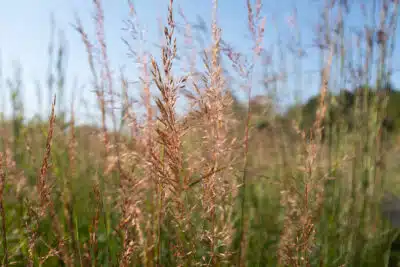 The health and well being of our natural environment is a top priority for the Land Stewardship team at Willowsford, that is why we conduct routine maintenance on our meadows, forests, trails, and open spaces. Brush hogging is one of our upkeeping practices to maintain and improve the overall health of our meadows and open spaces. Brush hogging is a non-invasive practice that breaks down brush that is present on the soil surface. The brush hog attachment uses a specific rotary cutting deck that trims down thick brush; it is typically attached to a tractor or Bobcat.
The health and well being of our natural environment is a top priority for the Land Stewardship team at Willowsford, that is why we conduct routine maintenance on our meadows, forests, trails, and open spaces. Brush hogging is one of our upkeeping practices to maintain and improve the overall health of our meadows and open spaces. Brush hogging is a non-invasive practice that breaks down brush that is present on the soil surface. The brush hog attachment uses a specific rotary cutting deck that trims down thick brush; it is typically attached to a tractor or Bobcat.
The brush hog attachment can cut tall grasses, weeds, shrubs, and even softwood saplings as thick as 3 inches and hardwood saplings up to 1.5 inches. The Land Stewardship team brush hogs once a year in late winter (March), to avoid disturbing grassland wildlife nesting season (April-September), provide overwintering habitat, and maintain grassland habitat.
There are many benefits of brush hogging besides for the aesthetic purpose. Clearing the tall grasses, weeds, and vines frees up more soil nutrients that allow native plants and wildflowers to thrive. This promotes biodiversity for the area and surrounding properties, like your backyard! Brush hogging can also create an ideal habitat for various wildlife species, improving the natural ecosystem of the area. It also preserves soil health while clearing the surface for other plants and vegetation to have an opportunity at growth. Brush hogging helps manage invasive species by suppressing their growth and slowing their spread.
We frequently get questions on why we brush hog once a year. Some people wonder why we don’t do it more often, while others wonder why we do it at all. To answer these questions, if the meadows were not brush hogged at all, they would no longer be meadows. Over time, shrubs and trees will grow in our grasslands and shade out the beneficial grasses in the area. Eventually, native grasses and flowers would no longer be able to grow in the area and the meadow would turn into a forest. Which isn’t an outright terrible thing, however, grassland habitat is unique and provides us and wildlife with many benefits like maintaining biodiversity, food production, and regulating ecological processes. Alternatively, brush hogging too frequently can interfere with wildlife habitat, as well as the life cycle of beneficial grasses and plants growing in the meadow.
So next time you notice a meadow that has been brush hogged, take note of how the plant diversity changes, do you see more natives? How about animals you’ve never seen there before? Be mindful of how it changes over the course of the year.
Side note: You may also hear people refer to brush hogging as bush hogging, these terms can be used interchangeably. However, a Bush hog is actually a brand name for a type of brush hog. Bush hogging is the more common phrase in the Appalachian region.
Written by: Emily Lawrence
